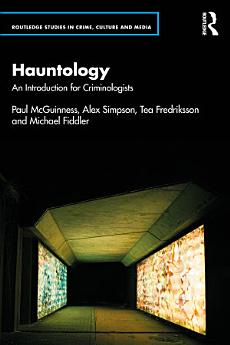Hauntology: An Introduction for Criminologists
About this ebook
Hauntology is, in essence, a mode of analysing the repressions, absences and lacks that shape our social world. The book outlines how criminological researchers may welcome hauntings into their work, to escape the ontological tethers of administrative criminology and to reveal the importance of absence in their work. Specifically, the book is structured around key criminological themes, from prisons to the environment, and examines how the lens of ‘haunting’ helps unlock new critical enquiry by revealing the voices that are all too often buried. In doing so, it presents an examination of how hauntological concepts can be ‘read’ criminologically as well as addressing how they can be used to expand criminological imagination.
Throughout the book, we use hauntology to amplify the significance of justice within criminology as an intellectual and ethical endeavour. We argue that a spectral attitude bolsters our ability to ‘do justice’ to our research, our questions, our participants, our subjects, our objects, and what counts as criminological knowledge.
The book is guided by the following objectives:
• To introduce the importance of hauntology for encountering the spectres repressed within criminological knowledge and research.
• To outline the key concepts of hauntology to offer new critical insight into their application across the field of criminology.
• To examine the multiple ways hauntology stretches the ontological and epistemological foundations of criminological research.
• To produce an approachable, comprehensive and theoretically driven compendium that both motivates and guides current and future research across all areas of criminology.
Hauntology: An Introduction for Criminologists is a guide for criminologists that is designed to, for the first time, help direct future hauntological research and enhanced learning capacity across the discipline of criminology.
About the author
Paul McGuinness is a Lecturer in Criminology and Sociology at the University of Sussex. His work seeks to combine criminology, hauntology and arts-based research, and takes inspiration from the study of, separately, cinema and cybernetics.
Alex Simpson is an Associate Professor in Criminology at Macquarie University, Sydney. His work stretches across sociology, geography and organisation studies, focusing on the cultural production of elite urban environments. He has written ethnographies on the financial services industry in the City of London and uses theories of atmosphere and affect to examine the spatial relations of gender, power and exclusion.
Tea Fredriksson is a Senior Lecturer at Stockholm University’s Department of Criminology. Her primary research interest is in spaces and processes that construct social belonging and otherness. Focusing on prisons, desistance journeys and cultural depictions of harm, she uses intersectional and hauntological frameworks to explore how society talks to and about itself through imag(inari)es of crime and punishment.
Michael Fiddler is an Associate Professor of Criminology at the University of Greenwich, London. His published research explores the ways in which space, architecture and visual arts coalesce to inform our understanding of crime and punishment.





